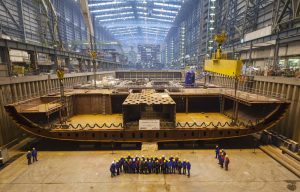 Q – I am an amateur architect, model builder, and avid reader of Scientific American. The construction of these new cruise ships has me really intrigued but I am curious about a starting point to learn more about the process. I am not expecting a lot of details but was wondering if someone on your staff could give me an overview so I have a feel for how to approach this subject. By the way, I’m 16 years old.
Q – I am an amateur architect, model builder, and avid reader of Scientific American. The construction of these new cruise ships has me really intrigued but I am curious about a starting point to learn more about the process. I am not expecting a lot of details but was wondering if someone on your staff could give me an overview so I have a feel for how to approach this subject. By the way, I’m 16 years old.
A – Shocking as it may seem, we do not employ any engineers with shipbuilding expertise eon our staff. We do, however, have someone who makes a decent Osso Buco. As you are the first reader under the age of 70 to correspond with us, we feel an obligation to respond as best we can. But this will be very general:
The ship is really a giant tube and so cutting holes through the tube while you are building can be risky. That is one of the major challenges faced by a team of perhaps 15-30 nautical architects working on any single project. How do you cut the tube without weakening the superstructure?
Some architects liken the ship-building process to constructing a spider web that starts in the hull section and comes up through the ship’s beams. But every third or fourth web has to be supported by a huge piece of steel.
Ships are, of course, built on land and then transferred to the water. But, strange as it seems, this usually requires that separate sections of the ship are actually built upside down. This allows the workers to weld downward instead of lying down with their backs toward the ground. Finally, the entire ship is pulled out of the dry dock where it is flipped over. The ship sits within gates and once construction reaches a certain point, the gates are opened, water enters, and the ship begins to float. At this point in the process, mistakes are rather easily noted. Hope this little bit helps. Thank you for reading our site.
